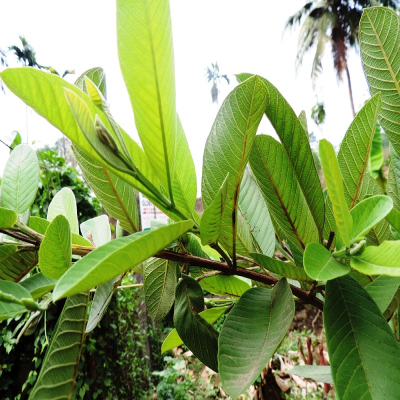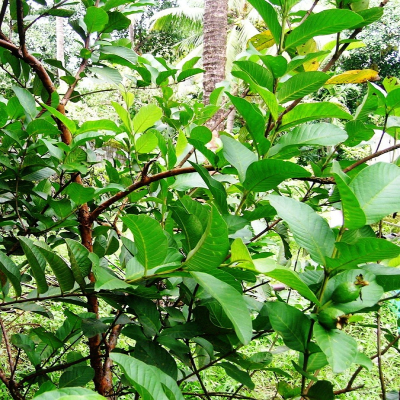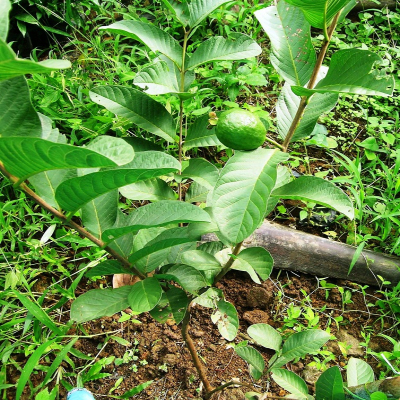Distribution and habitat: Cultivated through out India.
Botany: A small tree up to 8 m in height with smooth, pale pinkish brown bark, having grey patches exfoliating in very thin woody flakes.
- Leaves : Simple, opposite, light green oblong or elliptic oblong, glabrous above, pubescent beneath, pellucid- punctuate, lateral nerves 10-12 pairs jointed by intramarginal veins.
- Flowers : White, fragrant in axillary 1-3 flowered cymes.
- Fruits: Globose or pyriform berries often varying in size and shape, pulp yellowish white or red.
Chemical constituents: It contains considerable amount of pectin. Fruit contains arabinan composed of galacturonic acid, galactose, arbinose with traces of xylose and rhamnose. Leaves contain β-sitosterol, maslinic acid, guijavalic acid, asiatic acid,corosolic acid, oleanolic acid, ursolic acid etc. Pectin constituent are d- galacturonic acid, d- galactose, l- arabinose. Essential oil contains dl- limonene and 1, 8 cineole. Stem bark contains leutic and ellagic acid, leucocyanidane and glycoside amritoside.
Properties & Uses:
- The roots are astringent, hemostatic, anti-emetic and constipating.
- The leaves are astringent, anodyne, febrifuge, antispasmodic and tonic.
- The flowers are cooling, laxative and tonic.
- The fruits are sweet, astringent, sour, cooling, aphrodisiac, laxative and tonic.
- Used in hemorrhages, diarrhoea, dysentery especially in children, gingivitis, ulcers nephritis, cachexia, cholera, wounds, ulcers bronchitis, colic, ophthalmodynia, ulemorrhagia burning sensation, colic, dipsia, general debility
Formulations: Dasamularistam, Agastyarasayanam
Agro technology
Soil and climate: Sensitive to waterlogging. Can be grown on heavy but well-drained soil. The best soils are deep, friable and well-drained with a pH between 5.5 and 7.5. It is grown under tropical and subtropical climate.
Propagation: By seeds. Vegetative propagation can be done by air layering, cuttings, grafting, budding and rootstock.
Manures and fertilizers: A bearing guava tree should be fertilized with 300-400 g N, 250 g to 350 g each of P2O5 and K2O along with 30-40 kg farmyard manure each year. Foliar spraying of potassium (as potassium sulphate 1.0 to 2.0%), calcium (as calcium nitrate, 1.0 to 2.0 %) were found effective in increasing yield and improving fruit quality.
Irrigation: Hardly require any irrigation. In early stages of plant establishment, 8-10 irrigations a year is enough, while full grown bearing trees require watering during April to June at biweekly intervals to secure higher fruit-set and reduced fruit-drop.
Harvesting: The fruits turn greenish yellow with the advancement of maturity. Harvesting of guava needs extra care because the fruit has soft, thin skin. Normally carried out by hand to avoid physical injuries. Subsequent handling and transportation of the fruit also need extra precaution to reduce bruising.



